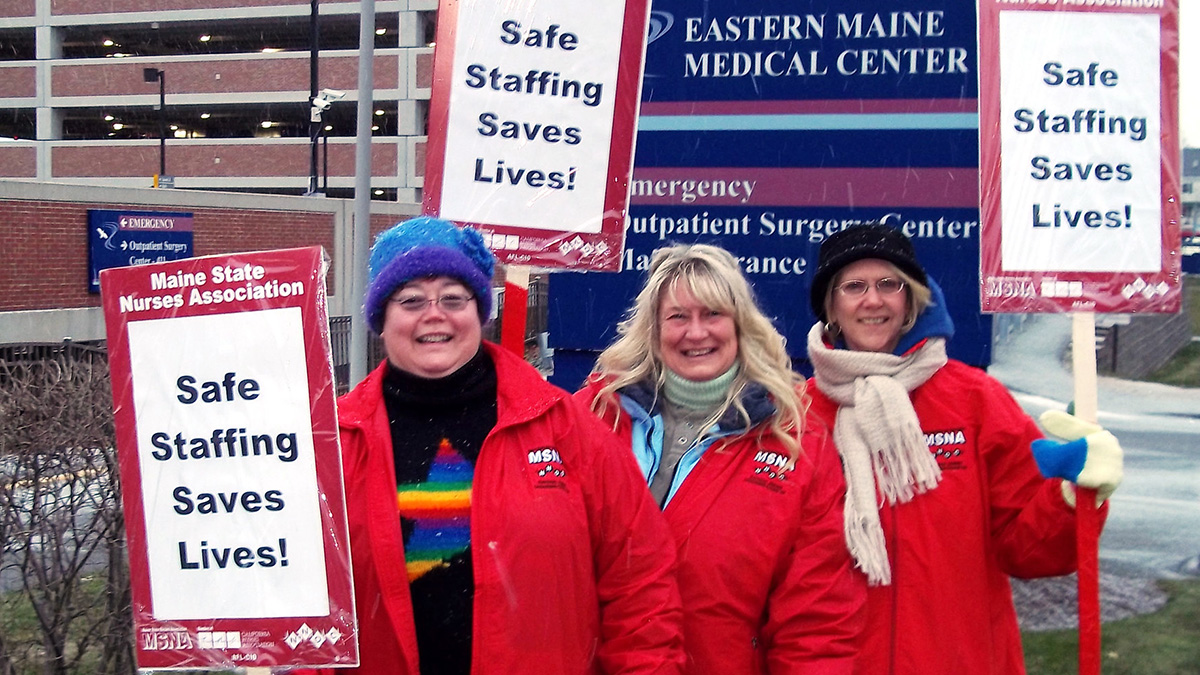Myths and facts about safe staffing

Our patients are at risk from unsafe registered nurse (RN) staffing. Nurses know this and research shows this. But hospital administrators are trying to stop us from solving the crisis — and they’re spreading misinformation about staffing.
We need to counter those myths with the truth — our patients are counting on us.
We’ve heard many of these myths before. They came up in California, where nurses won staffing ratios 24 years ago. Here’s what the research — and nurses’ own experience — has to say.
Myth #1: There is no direct link between mandated nurse staffing ratios and improved patient outcomes.
Fact:
The number of patients assigned to a nurse directly impacts our ability to appropriately assess, monitor, care for, and safely discharge our patients. It’s just common sense, when nurses have fewer patients to care for, we have more time to care for each patient. And we have decades of research to back it up. Below are just a few examples.
- Each additional patient per nurse in hospital medical-surgical units increased the odds of death within 30 days by 16% and increased the odds that a patient would have a longer length of stay by 5% (Lasater, et al.; 2021; BMJ).
- “Hospital nurse staffing ratios mandated in California are associated with lower mortality and nurse outcomes predictive of better nurse retention in California and in other states where they occur” (Aiken, et al; 2010; Health Serv. Res.).
Myth #2: We won’t be able to meet the ratios because there aren’t enough nurses.
Fact:
Maine has more RNs working today than at any time in the past. Maine also has a massive surplus of licensed RNs who are not working because of unsafe staffing and their inability to provide all the care their patients need. Safe staffing ratios will bring nurses back to the bedside.
Myth #3: Safe staffing ratios would cost Maine’s hospitals too much, forcing them to close or cut services.
Fact:
Evidence and experience demonstrate that safe staffing is a cost-effective way to improve patient care and can lead to savings for our hospitals, nursing homes, and our health care system.
Fact:
Unsafe staffing hurts the bottom line by increasing rates of costly hospital-acquired infections, patient falls, 30-day readmissions, medical malpractice, nurse burnout and staff turnover, when compared to health care facilities that meet safe staffing levels.
Fact:
Not one California hospital closed because of ratio implementation. In California, hospital income rose dramatically after ratios were implemented, from $12.5 billion from 1994 to 2003, to more than $20.6 billion from 2004 to 2010. Not one California hospital closed because of ratio implementation (Medicare Cost Reports, 1994 - 2010).
Myth #4: Hospitals need flexibility in staffing – fixed ratios won’t meet the needs of patients.
Fact:
Safe staffing ratios set a minimum standard based on research, evidence, and best practices. Ratios will provide a safe minimum level of staffing. Hospitals will still have flexibility in staffing – but they cannot go below the levels that the research demonstrates are safe. The truth is that when there are more RNs onsite hospitals are better prepared to respond to unexpected situations.
Myth #5: Hospitals will have to lay off other caregivers if safe staffing ratios are implemented.
Fact:
Non-nurse staffing levels at hospitals increased after safe staffing ratios were implemented in California.
The number of total nursing assistive personnel increased by 64% in California hospitals since 2005, after the ratios were implemented. That is a rate 54% higher than the rate of increase of hospital nursing assistive personnel nationally (American Hospital Association Annual Survey 2005 - 2010).
Myth #6: Emergency departments will have longer wait times or have to go on diversion status.
Fact:
California implemented safe staffing ratios in 2004. Between 2003 and 2007, ambulance diversion decreased by 45% (California HealthCare Foundation 2009).
Myth #7: Maine hospitals are rated much higher than California hospitals.
Fact:
The Agency for Healthcare Research and Quality analysis of hospitals found that both Maine and California scored “strong,” though California had somewhat higher scores in a few areas (Agency for Healthcare Research and Quality, National Healthcare Quality and Disparities Reports, Data Tools, Setting of Care: Hospitals).
Some hospital industry executives have been citing quality scores comparing Maine to California, claiming that California has lower scores. Their claims are based on self-reported survey responses to a controversial rating organization and on an Agency for Healthcare Research and Quality report that considers Maine and California as whole, not their hospital performance.
Learn more about the Maine State Nurses Association campaign for safe staffing ratios here.